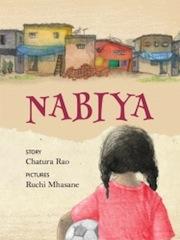

The book is a-slice-of-life story of a little girl, Nabiya, and her empathetic teacher. Nabiya lived in a slum, where life is a struggle for survival with not much scope to indulge in luxuries such as books.
However, Nabiya was lucky enough to go to school where she found an ally in an understanding teacher. A teacher who noticed Nabiya's fascination for words and stories. When she saw a story-book for the first time, she was mesmerized by it and conjured up images in her mind, images that were far removed from her reality.
NABIYA offers the reader a glimpse into the lives of children who live in crowded slums. We see the narrow congested streets that are so narrow that, A man and his buffalo couldn’t walk there side by side!
We see how pronounced class distinction is in our society, when Nabila’s Ammi announces, ‘ People who live in big buildings don’t visit our homes…’ even though, Ammi keeps hers spotlessly clean.
We see how concerned the mother is about Nabiya ruining her new dress if she played in the street, as perhaps that is the only new dress that she would be getting for the year; for the holy festival of Eid.
The book tries to pack in too many diverse elements and so the focus is somewhat lost. However, that said, it still is a great opportunity to ‘see’ children from underprivileged families, such as Nabiya's, as real people, people who have their joys, sorrows and concerns, hopes and aspirations, and yet continue to plod along in hope of better days ahead.
The illustrations are remarkable, and make the book come alive. The soft pastel shades of the water-colours, exude warmth and greatly add to the appeal of the book.